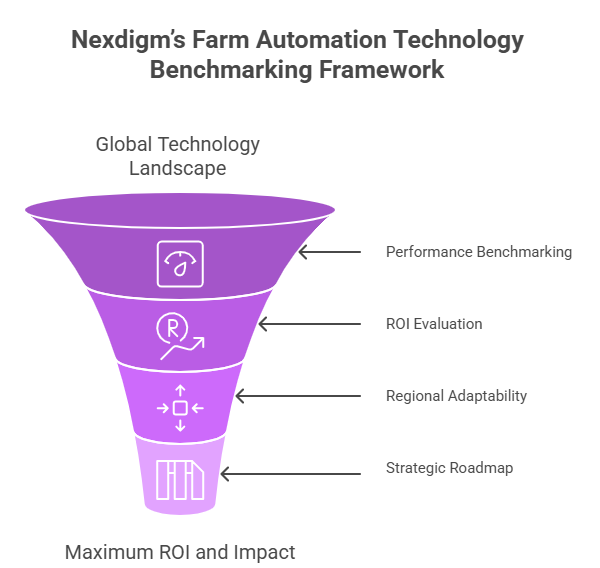Farm automation has emerged as one of the most transformative forces in modern agriculture. From autonomous tractors and robotic harvesters to drone-based spraying systems and AI-driven irrigation, automation is revolutionizing how food is cultivated, monitored, and delivered.
However, the performance and scalability of these technologies differ widely across global markets. What works seamlessly on large commercial farms in North America may not yield the same results in smallholder setups in Asia or Africa. These regional disparities, combined with rising investment costs, create a pressing need for data-backed technology comparison.
This is where technology benchmarking becomes essential. By comparing automation tools based on operational efficiency, adaptability, and total cost of ownership across global geographies, agri-enterprises can identify which technologies deliver measurable outcomes.
Nexdigm’s Farm Automation Technology Benchmarking Framework
Adopting the right automation tools demands comparative, evidence-based insights into how technologies perform across different agricultural environments. Nexdigm’s Farm Automation Technology Benchmarking Framework offers a structured methodology that evaluates tools on technical efficiency, operational adaptability, and financial viability across global markets.
By combining competitive intelligence, technology benchmarking, and regional performance analytics, Nexdigm empowers agri-enterprises, equipment manufacturers, and policymakers to make informed, high-impact automation decisions.
Core Components of the Framework

- Global Technology Landscape & Classification: Nexdigm maps the full spectrum of farm automation tools, identifying maturity levels, innovation trends, and adoption hotspots across regions.
- Performance & Capability Benchmarking: Technologies are assessed on key performance metrics such as fuel and energy efficiency, field coverage, automation accuracy, downtime frequency, and operating cost per hectare. These comparisons reveal which tools consistently deliver efficiency and cost optimization across varying farm sizes and climates.
- ROI & Cost-to-Value Evaluation: Our benchmarking models assess capital cost, maintenance overhead, productivity gains, and payback timelines, helping decision-makers justify investments with measurable financial outcomes.
- Regional Adaptability Analysis: Nexdigm benchmarks automation tools across diverse agricultural conditions to evaluate scalability and performance variation.
- Strategic Adoption Roadmap: The insights culminate in a data-backed automation strategy outlining technology prioritization, vendor shortlisting, and regional deployment sequencing to ensure maximum ROI and operational impact.
Through this comprehensive framework, Nexdigm transforms automation selection into a science, helping organizations shift from experimentation to strategic execution. By contextualizing technology performance globally, we enable clients to adopt the right tools, in the right markets, at the right scale.
How Farm Automation Differs Across Markets
The performance and scalability of farm automation technologies vary dramatically across regions, shaped by differences in farm size, labor dynamics, climate, infrastructure, and policy frameworks. A global benchmarking perspective highlights these variations, helping agribusinesses and equipment providers identify where certain technologies thrive and where they need adaptation.
Here’s how automation adoption and outcomes differ across key agricultural markets:
- North America and Europe (Mature, High-Tech Ecosystems): Large-scale commercial farms in the U.S., Canada, Germany, and France are at the forefront of autonomous machinery and precision robotics. High labor costs, strong R&D ecosystems, and advanced data infrastructure drive widespread adoption of automated tractors, AI-based weeding robots, and drone fleets for crop monitoring. Benchmarking in these markets focuses on energy optimization, machine uptime, and predictive maintenance analytics to sustain competitiveness.
- Asia-Pacific (Customization for Smallholder and Cooperative Models): In India, China, and Southeast Asia, automation is adapting to fragmented landholdings and mixed crop systems. Affordable drone sprayers, compact robotic planters, and shared automation models are redefining efficiency. Nexdigm’s benchmarking captures how cost-efficiency, adaptability, and ease of use outperform full automation when scalability is limited by farm size and capital access.
- Middle East and Africa (Early-Stage Automation and Resource Adaptation): These regions are prioritizing automation solutions that address water scarcity, energy constraints, and labor availability. Solar-powered irrigation, IoT-based soil monitoring, and drone analytics are emerging as scalable innovations. Benchmarking highlights durability, resource utilization, and modular design as the most critical success factors for these geographies.
Through Nexdigm’s global benchmarking datasets, stakeholders can assess which technologies demonstrate consistent ROI, resilience, and operational reliability across markets. This comparative intelligence helps manufacturers localize solutions and assists governments and agri-enterprises in adopting the right technologies for the right environments, ensuring automation drives both profitability and sustainability.
To take the next step, simply visit our Request a Consultation page and share your requirements with us.
Harsh Mittal
+91-8422857704

